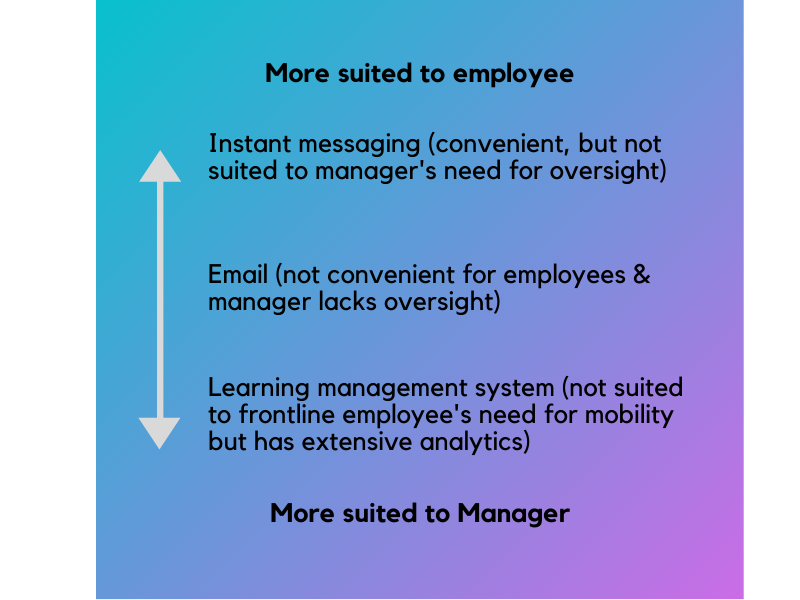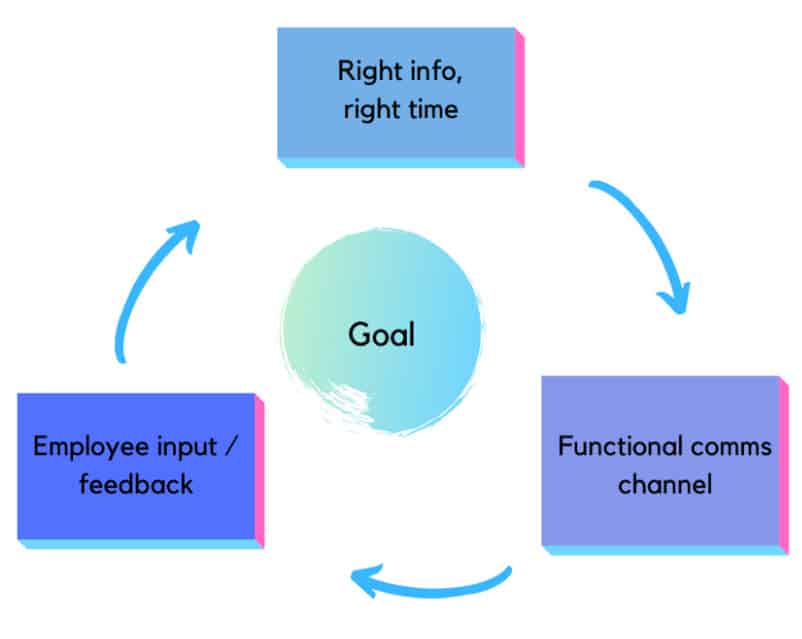When management is able to establish a good workflow with the frontline team, your business does better. Employees know what they need to do, and they have the resources to get it done. They’re more engaged and productive, and they feel better about their work. It also means that the team is working as its supposed to do, so that the business can achieve its goals and hit those KPIs.
When the link between management and the frontline is broken, we’ve all been there and things can really go sideways. Missed deadlines, misallocation of resources, personal frustration, and talk of who’s to blame. It’s not a good place to be, and the organization and the people who work in it suffer as a result.
The good news is that there’s a lot you can do as a manager to determine what kind of working relationship you have with your frontline. Here are 3 steps you can take to create an effective process with your frontline.
1: Provide employees the right information at the right time
Often the reason a plan falls through is because we’re lacking the knowledge we need to succeed.
For frontline employees, getting the right information at the right time is particularly challenging. They’re on the go, and they don’t have time to log into the company intranet to read a PowerPoint or PDF (not that those formats are especially engaging anyway). They’re also reluctant to download apps for work which aren’t directly related to their jobs.
The key to informing and communicating with deskless employees is simplicity and clarity: Bite-sized content is the most effective way to inform frontline employees. In our personal lives, social media has compressed the way we communicate when we’re on the go. This has trickled over into the workplace too, as our preferences for instant messaging and short-form video has become dominant.
You might be thinking, “well that’s great to know, but what does this mean for my team?”
The answer is that to optimize the link with your frontline workforce, you must explore solutions which enable you to quickly and easily create the right content, and share it with employees when it suits you. This brings us to our next point.
2: Find a way to communicate which suits both your and your employee’s needs
To have a great link with your frontline which enables you to achieve goals again and again, it has to meet the needs of both parties on a daily basis.
To date, most solutions have only met the needs of either employees or managers!

Instant messaging is the preferred communications channel for 71% of deskless employees. The simplicity and speed IM offers makes it the preferred channel for employees, but IM lacks the functionality a manager needs to get the full picture of what his/her workforce is doing, and the types of content you can share on it are relatively limited.
On the other hand, learning management solutions offer a wide variety of features and data that in theory are interesting for managers, but their cumbersome nature means that employees rarely use them and managers aren’t able to benefit from the features.
In brief, you need to find a solution which suits your employee’s need for mobility and engaging content, but you also need a solution which is comprehensive enough so that you get the full picture of your workforce’s status in real time.
A new approach to this is that of instant knowledge sharing. It’s a defining new category of solution which suits the needs of both managers and employees, and we’ll come to that in a bit.
3: Create opportunities for employees to respond, provide input and feedback
The main thing about employee engagement is that it’s a two way street. Frontline employees are the face and backbone of your business. They’re often the first people customers interact with or those who build the products that customers enjoy. They are an enormously important part of your business, and a key source of critical information for management.
For them to be truly engaged and for the workflow to be effective, its key for there to be an opportunity for them to provide input and feedback, and to ask questions about the information they receive from management. This is part of the cycle enables management to learn about what is working on the ground, what needs to be re-evaluated, and how to improve the working relationship with the frontline going forward.
Choose a solution which suits your needs as a manager and those of your employees
You need a solution which enables you to wake up in the morning with an idea and then share the right information with your employees, so that by end of day that idea can be implemented.
To reach this level of effectiveness and agility, the solution has to provide a great user experience for you as a manager, and for your employees as well. Specifically for managers, you must be able to:
- Create the right content easily and intuitively (short video, or images are preferred by employees)
- Reach employees quickly (share seamlessly via the familiar channels employees are most attentive to)
- Get the full picture with an analytics dashboard so you can measure progress and identify knowledge gaps
For employees, the key requirements for a great user experience are:
- Use of engaging formats (short video)
- On-the-go learning (ability to complete training remotely)
- Delivery via familiar channels (instant messaging)
- Opportunity to give feedback and ask questions




















